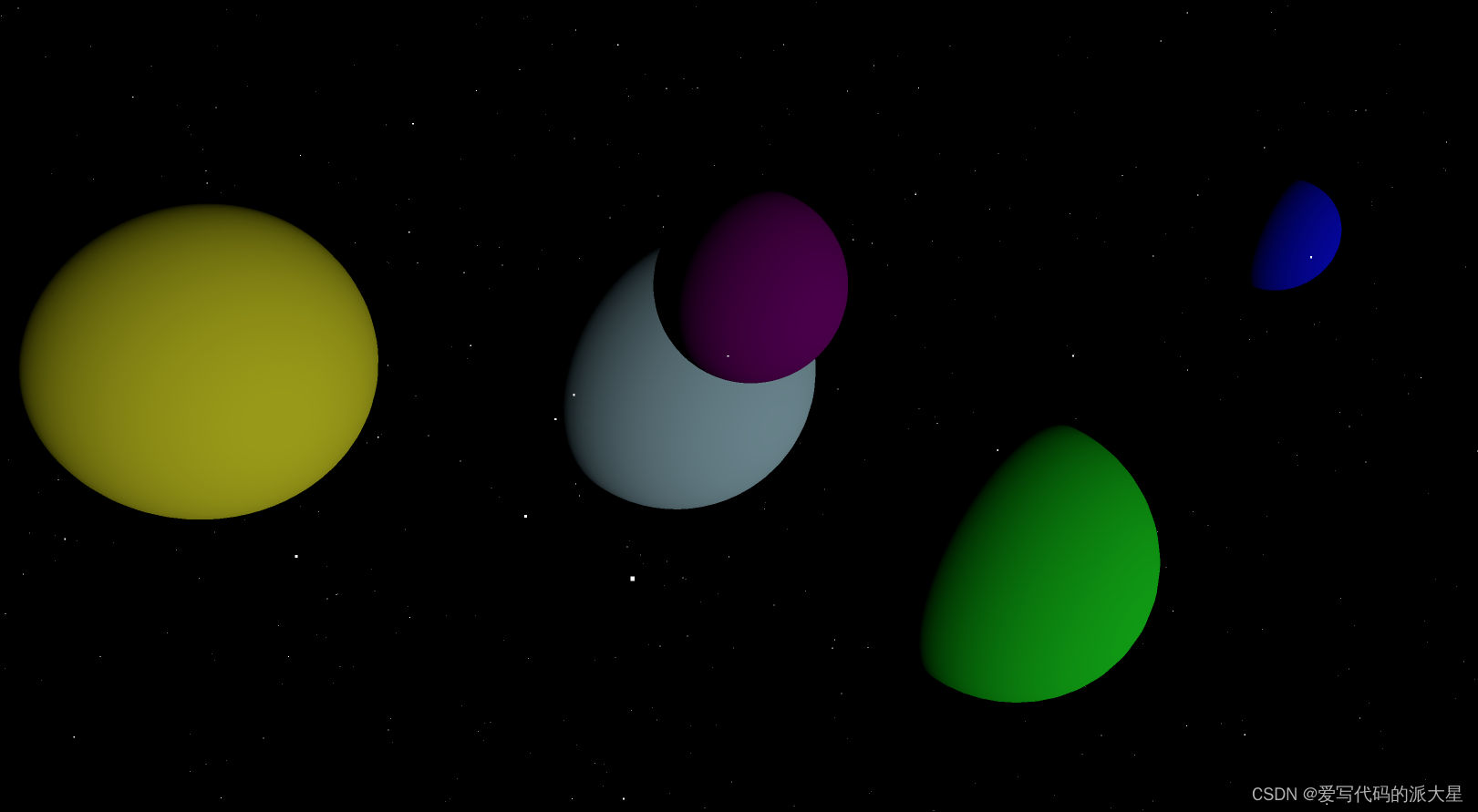2023.9.12今天我学习了vue2+three.js实现一个好看的动态效果:
 首先是安装:
首先是安装:
npm install three
相关代码如下:
<!--3d宇宙效果-->
<template>
<div>
<div id="content" />
</div>
</template>
<script>
import * as THREE from 'three'
export default {
data() {
return {
scene: null,
camera: null,
renderer: null,
mesh: null,
light: null,
stars: null,
mesh3: null
}
},
mounted() {
this.init()
this.animate()
},
methods: {
init() {
// 创建场景
this.createScene()
//创建照相机
this.createCamera()
// 创建渲染器
this.createRenderer()
// 创建物体
this.createMesh()
// 创建星空
this.createStars()
//触发
this.render()
},
// 创建场景
createScene() {
this.scene = new THREE.Scene()
this.light = new THREE.DirectionalLight(0xffffff, 1)
this.light.position.set(100, 100, 100)
this.scene.add(this.light)
},
createStars() {
const geometry = new THREE.BufferGeometry()
const positions = []
for (let i = 0; i < 10000; i++) {
const x = THREE.MathUtils.randFloatSpread(2000)
const y = THREE.MathUtils.randFloatSpread(2000)
const z = THREE.MathUtils.randFloatSpread(2000)
positions.push(x, y, z)
}
geometry.setAttribute('position', new THREE.Float32BufferAttribute(positions, 3))
const material = new THREE.PointsMaterial({color: 0xffffff})
this.stars = new THREE.Points(geometry, material)
this.scene.add(this.stars)
},
// 创建相机
createCamera() {
this.camera = new THREE.PerspectiveCamera(45, window.innerWidth / window.innerHeight, 0.1, 1000)
this.camera.position.set(200, 200, 200)
this.camera.lookAt(this.scene.position) // 设置相机方向(指向的场景对象)
},
// 创建渲染器
createRenderer() {
this.renderer = new THREE.WebGLRenderer()
this.renderer.setSize(window.innerWidth, window.innerHeight)
this.renderer.setClearColor(new THREE.Color(0x000000))
document.getElementById('content').appendChild(this.renderer.domElement)
},
// 创建物体
createMesh() {
let geometry1 = new THREE.SphereGeometry(40, 40, 40)
let material1 = new THREE.MeshLambertMaterial({
color: 0x00ff00
})
this.mesh = new THREE.Mesh(geometry1, material1)
this.mesh.position.set(0, 0, 0)
this.scene.add(this.mesh)
let geometry2 = new THREE.SphereGeometry(50, 50, 50)
let material2 = new THREE.MeshLambertMaterial({
color: 0xADD8E6
})
let mesh2 = new THREE.Mesh(geometry2, material2)
mesh2.position.set(-40, 0, 0)
this.scene.add(mesh2)
let geometry3 = new THREE.SphereGeometry(30, 50, 50)
let material3 = new THREE.MeshLambertMaterial({
color: 0x800080
})
this.mesh3 = new THREE.Mesh(geometry3, material3)
this.mesh3.position.set(160, 0, 0)
this.scene.add(this.mesh3)
let geometry4 = new THREE.SphereGeometry(35, 50, 50)
let material4 = new THREE.MeshLambertMaterial({
color: 0xFFFF00
})
let mesh4 = new THREE.Mesh(geometry4, material4)
mesh4.position.set(-20, 80, 150)
this.scene.add(mesh4)
let geometry5 = new THREE.SphereGeometry(15, 50, 50)
let material5 = new THREE.MeshLambertMaterial({
color: 0x0000FF
})
let mesh5 = new THREE.Mesh(geometry5, material5)
mesh5.position.set(120, 80, -80)
this.scene.add(mesh5)
this.render()
},
// 触发
render() {
this.renderer.render(this.scene, this.camera)
},
animate() {
// 计算时间差
const time = Date.now() * 0.001
// 根据时间变化更新球体和光源的位置
this.mesh.position.set(100 * Math.cos(time), 100 * Math.sin(time), 0)
this.mesh3.position.set(0, 50 * Math.cos(time), 100 * Math.sin(time))
this.light.position.set(50 * Math.cos(time), 50 * Math.sin(time), 0)
// 触发渲染
this.render()
// 不断循环调用 animate 函数
requestAnimationFrame(this.animate)
},
}
}
</script>